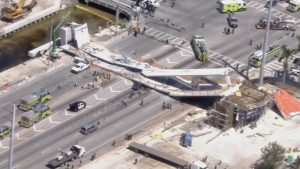Miami Bridge Collapse – Is Blame Part of Your Investigation Policy?

I was listening to a news report on the radio this morning about the pedestrian bridge collapse in Miami. At one point, they were interviewing Florida Governor Rick Scott. Here is what he said:
“There will clearly be an investigation to find out exactly what happened and why this happened…”
My ears perked up, and I thought, “That sounds like a good start to a root cause investigation!”
And then he continued:
“… and we will hold anybody accountable if anybody has done anything wrong,”
Bummer. His statement had started out so good, and then went directly to blame in the same breath. He had just arrived on the scene. Before we had a good feel for what the actual circumstances were, we are assuming our corrective actions are going to pinpoint blame and dish out the required discipline.
This is pretty standard for government and public figures, so I wasn’t too surprised. However, it got me thinking about our own investigations at our companies. Do we start out our investigations with the same expectations? Do we begin with the good intentions of understanding what happened and finding true root causes, but then have this expectation that we need to find someone to blame?
We as companies owe it to ourselves and our employees to do solid, unbiased incident investigations. Once we get to reliable root causes, our next step should be to put fixes in place that answer the question, “How do we prevent these root causes from occurring in the future? Will these corrective actions be effective in preventing the mistakes from happening again?” In my experience, firing the employee / supervisor / official in charge rarely leads to changes that will prevent the tragedy from happening again.



